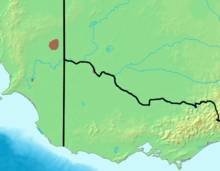Black-eared miner
| Black-eared miner | |
|---|---|

| |
| Scientific classification | |
| Domain: | Eukaryota |
| Kingdom: | Animalia |
| Phylum: | Chordata |
| Class: | Aves |
| Order: | Passeriformes |
| Family: | Meliphagidae |
| Genus: | Manorina |
| Species: | M. melanotis
|
| Binomial name | |
| Manorina melanotis (Wilson, FE, 1911)
| |

| |
| Distribution of the black-eared miner | |
The black-eared miner (Manorina melanotis) is an endangered honeyeater endemic to mallee woodland in south-eastern Australia.
Taxonomy
Manorina melanotis was identified by Francis Erasmus Wilson in 1911.[2] It is closely related to the much more widely distributed yellow-throated miner M. flavigula, and the taxonomic status of the black-eared miner is the subject of some controversy, with some researchers considering it a subspecies of M. flavigula.[3]
Behaviour
Black-eared miners are
In 2022, it was reported that the species had been interbreeding with the yellow-throated miner.[4]
Distribution and habitat
IBA (Important Bird and Biodiversity Areas), identified by BirdLife International as being important for black-eared miner conservation, are areas containing relatively intact, mallee woodland in north-western Victoria and south-eastern South Australia. They comprise Murray-Sunset, Hattah and Annuello, the Riverland Mallee, and Wyperfeld, Big Desert and Ngarkat.[5]
Conservation status

Black-eared miners' survival became threatened by habitat clearance to make way for agriculture, and the bird experienced competition from goats, rabbits,
As of 2022[update], there remain around 200 colonies, with up to 20 birds within each colony. Interbreeding with the yellow-throated miner has affected the genetic integrity of the black-eared miner, which adds to the risk to their population.[4]
The species is listed as endangered on the IUCN Red List (2021.3) and under the Australian Environment Protection and Biodiversity Conservation Act 1999,[2] and its conservation status in several Australian states is as follows:
- New South Wales: Listed as "Critically Endangered" by the Biodiversity Conservation Act 2016 (NSW), as of February 2022.[2]
- National Parks and Wildlife Act 1972, as of January 2020.[2]
Conservation measures
In July 2022, it was announced that AUD$125,000 has been dedicated to protect the black-eared miner. The Australian Government has provided the funding to the Murraylands and Riverland Landscape Board (MRLB) and their partners for the project.[12] As part of the project, researchers will do genetic testing of birds in the 200 populations.[4]
See also
References
- . Retrieved 12 November 2021.
- ^ Species Profile and Threats Database. Department of Climate Change, Energy, the Environment and Water, Australian Government. Retrieved 11 July 2022.
- ^ S2CID 216212426. Retrieved 25 February 2024.
- ^ a b c d Landau, Sophie (9 July 2022). "Endangered black-eared miner to be scrutinised by researchers to learn extent of cross-species breeding". Australia: ABC News. Retrieved 11 July 2022.
- ^ "Black-eared Miner". Important Bird Areas. BirdLife International. 2012. Archived from the original on 10 July 2007. Retrieved 4 November 2012.
- ^ "Black-eared Miner - profile". Office of Environment and Heritage. NSW Government. Retrieved 23 September 2023.
- ^ McLaughlin, John (26 May 2016). "The Identification of the Endangered Black-eared Miner Manorina melanotis". Australian Field Ornithology. 15 (3). Retrieved 11 July 2022.
- ISBN 978-1-74208-039-0.
- ^ "Listed Items". Department of Sustainability and Environment, Victoria. Archived from the original on 18 July 2005.
{{cite web}}: CS1 maint: unfit URL (link) - ^ "Flora and Fauna Guarantee Act: Action Statement Index by Category and Scientific Name". Department of Sustainability and Environment, Victoria. Archived from the original on 11 September 2006.
{{cite web}}: CS1 maint: unfit URL (link) - ^ Lowe, Sam (8 July 2022). "New conservation project to protect endangered species". The Murray Valley Standard. Retrieved 11 July 2022.
External links
- BirdLife Species Factsheet
- Photos and audio of black-eared miner from Cornell Lab of Ornithology's Macaulay Library
- Recordings of black-eared miner from Graeme Chapman's sound library
- Australian Government Department of Climate Change, Energy, the Environment and Water Species Profile and Threats Database: Manorina melanotis – Black-eared Miner (Commonwealth Documents)

